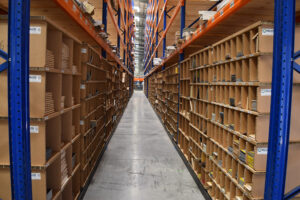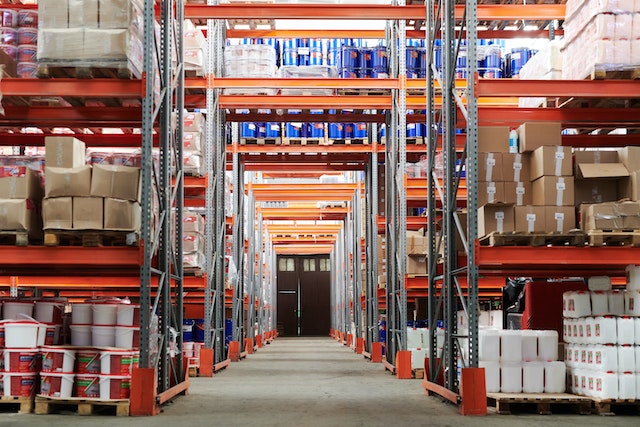The Importance of a Well-Planned Warehouse Setup
In the fast-paced world of supply chain management, the layout of your warehouse is more than just a blueprint. It’s the backbone of your entire operation and a key driver of productivity, efficiency, safety and costs.
Here, we go into some of the most common warehouse layout mistakes that hinder performance. We will explore the importance of optimising warehouse layouts, examine key problem areas, and outline best practices to help avoid these pitfalls.
Why Warehouse Layout Matters
The warehouse layout fundamentally impacts all major aspects of your supply chain and warehouse operations. Here’s why it is so crucial:
Enhances Productivity
An effective warehouse layout streamlines movement and flow of goods, smooths workflows, eliminates non-value activities, and optimises storage. This boosts productivity by allowing faster processing and order fulfilment.
Improves Warehouse Management
With well-planned warehouse zones, clear storage locations, and efficient workflows, warehouse operations become leaner and easier to manage. Inventory tracking and order processing is enhanced, reducing inefficiency and inaccuracy.
Lowers Operational Costs
When warehouse activities flow smoothly, labour costs are dramatically reduced as less time and effort is spent on mundane processes. Well-planned storage also reduces the need for excessive inventory.
Maximises Space Utilisation
Careful blueprinting ensures you make the most of every inch of your warehouse real estate by identifying redundant areas and strategically organising storage and work zones.
Enhances Safety
Clear aisles, ample space, good visibility, proper equipment, and smart workflows minimise safety hazards for warehouse staff.
In summary, the warehouse layout has a direct impact on key performance indicators – from productivity to costs to safety. Thus, avoiding common design mistakes is imperative.

What is a Pick Path and Why Does It Matter?
The pick path is the route warehouse pickers take through aisles and racks to collect items for an order. This route impacts:
- Travel distance – Longer routes increase time taken to pick items
- Ease of picking – A cramped pick path hampers access to items
- Bottlenecks – Pick traffic jams reduce productivity
Thus, optimising the pick path by reducing travel distance, avoiding backtracking, and preventing congestion is vital. Consider:
- Frequency of picks for items
- Dimensions of warehouse
- Placement of fast-moving items
A well-planned pick path boosts picker productivity. A flawed pick path adds hidden costs through inefficiency.
Common Warehouse Layout Blunders
When designing or modifying warehouse layouts, managers often overlook key elements, leading to easily avoidable but highly damaging mistakes.
Inadequate Quality Control Area
The quality control and inspection area for incoming shipments is crucial for verifying supplies. But often warehouse designers neglect to provision sufficient space and resources for this activity. This leads to:
- Delayed goods receipt
- Inability to thoroughly inspect supplies
- Increased quality issues
Insufficient Temporary Storage
Warehouse processes involve interim storage needs – quarantined stock, packed orders awaiting dispatch etc. Not allocating space for this can lead to:
- Workflow bottlenecks
- Clutter obstructing movement
- Slower order processing
Flawed Receiving Area Design
The shipping/receiving dock design impacts efficiency of loading/unloading. Typical receiving area mistakes include:
- Not enough docks for volume
- Docks too far from storage areas
- Lack of space for staging inbound goods
This hinders smooth receiving operations.
Ignoring Technology
Warehouse management software and automation solutions can improve most processes. But many layouts do not account for technology enablement, making integration difficult later.

The Pitfalls of Using the Wrong Equipment
Imagine deploying a forklift where a conveyor belt would be more efficient. Sounds like a minor hiccup, right? Well, it’s not. Using inappropriate equipment in your warehouse can have a domino effect that you don’t want to set off. First and foremost, it can significantly decrease efficiency and productivity. Your workers will spend more time manoeuvring bulky equipment, leading to increased fatigue and, consequently, reduced output.
But that’s not all. The energy consumption of your warehouse can skyrocket, adding an unnecessary burden to your operational costs. Speaking of costs, let’s not forget the investment you made in that high-end equipment that’s now sitting underutilised, eating away at your ROI.
And perhaps the most concerning of all is the safety hazards that come with material mishandling. Using the wrong equipment can compromise the safety of your workforce, leading to accidents that could have been easily avoided.
The Art of Choosing the Right Equipment
So, how do you sidestep these pitfalls? The answer lies in meticulous planning and assessment. Start by understanding the specific workflow needs of your warehouse. What are you storing? How quickly do items need to move from one point to another? These questions will help you gauge the required load capacity for your equipment.
Next, perform a cost-benefit analysis for different types of equipment. It’s not just about what’s cheaper; it’s about what brings the most value to your operations. And don’t forget to consider the future. Your warehouse will grow, and the last thing you want is to outgrow your equipment. Make sure whatever you choose can scale with your business.
Last but not least, prioritise the safety and ergonomics for your workers. After all, a safe worker is a happy worker, and a happy worker is a productive one.
By taking the time to assess your needs and make informed decisions, you can avoid the common mistake of using the wrong equipment, ensuring that your warehouse runs like a well-oiled machine.
Optimising Warehouse Space
With real estate costs being significant, proper usage of warehouse space is essential. Some key steps include:
Preventing overstocking
- Maintain precise inventory tracking
- Follow a lean stocking approach based on demand
- Regularly review and optimise stock levels
Streamlining rack layout
- Utilise vertical space thoroughly for pallet racking
- Place fastest moving goods on easily accessible racks
- Ensure adequate clearance between racks
Maintaining ample aisle width
- Refer safety regulations for minimum aisle width
- Map high traffic zones and size aisles accordingly
- Mark aisles clearly for easy navigation
Pallite’s selection of PIX units is the perfect fit for businesses looking for modular, space saving warehouse storage that flexes around your inventory. You can view the PIX range here or talk to one of the team to discuss how it could improve your warehouse set-up.

The Strategic Significance of Rack Placement
When it comes to the layout of your warehouse, the placement of racks and shelves is far from trivial. In fact, it’s a critical component that directly influences several aspects of your operations, from picking efficiency and storage density to safety and material handling. Imagine a picker having to backtrack multiple times because the racks are not aligned with the optimal picking path. Not only does this waste time, but it also increases the likelihood of errors and accidents.
So, how should you go about placing your racks? Start by ensuring they complement the picking path to eliminate unnecessary backtracking. This is especially crucial for the fastest-moving items, which should be strategically placed near the shipping areas for quick and easy access. But while you’re at it, don’t forget the basics. Make sure your racks do not obstruct essential elements like lighting or ventilation. Safety is paramount, and that includes allowing enough space for forklift manoeuvrability between racks. Lastly, clarity is key. Mark your rack sections clearly for easy identification, so that workers can find what they need without a second thought.
Achieving Inventory Balance
Inventory management is a balancing act that many struggle to perfect. On one hand, excess inventory can be a silent killer, straining both your warehouse space and your cash flow. On the other hand, insufficient inventory can lead to stock-outs, damaging customer relationships and your reputation. So, how do you find that elusive middle ground?
Begin by classifying your inventory based on how quickly items move—high, medium, or low velocity. This will give you a clearer picture of what needs to be readily available and what can be stored further away. Next, delve into historical order data to predict future demand. This will enable you to make more informed decisions about stock levels. But don’t stop there. Implement software tools designed to optimise these levels, providing real-time insights and automating tasks like reordering.
Establishing robust replenishment planning protocols is another must. Know when to reorder and how much to reorder to avoid both stock-outs and overstocking. And since demand is not static, keep an eye on trends and seasonal factors that could affect it. Mark and track buffer stock appropriately so that you’re never caught off guard.
Receiving Area Best Practices
A well-developed receiving area improves efficiency right from the start. Follow these guidelines:
- Provision adequate shipping docks as per order volumes
- Ensure docks are close to putaway zones
- Design efficient staging space for unloading
- Streamline traffic flow for inbound and outbound shipments
- Use technology like barcode scanning and sensors
- Prioritise worker safety and ergonomics
Creating Efficient Warehouse Operations
Boosting productivity involves strategic warehouse design and process improvements:
Enhancing workflows
- Eliminate redundant motion and distance
- Coordinate activities for seamless flow
- Create properly thought out facility zones and layout
Driving safety
- Implement safety protocols like traffic markings
- Ensure adequate walkway width
- Eliminate blind turns or corners
- Provide protective employee gear

Planning for Growth and Flexibility
Warehouse needs evolve with business growth. The layout design should accommodate future expansions through:
- Scalable storage solutions like pallet racks rather than fixed shelving
- Moving non-core activities offsite to free up space
- Allocating space for additional shipping docks
- Adaptable zoning and workflows
- Modular warehouse layout strategy
Key Takeaways
- Warehouse layout has a huge impact on key performance metrics
- Flawed layouts can significantly diminish productivity and efficiency
- Optimising pick paths is vital for efficient order picking
- Common mistakes like poor racking, congestion, and neglecting technology must be avoided
- Warehouse layout must balance space, inventory levels, and workflows
- Proper equipment selection prevents safety issues and bottlenecks
- Design layouts while keeping future business growth in mind
The Roadmap to an Efficient Warehouse
In the realm of warehouse management, the layout is not just a plan on paper; it’s a dynamic blueprint that influences every facet of your operations. From the moment goods arrive at the receiving area to the point they are dispatched from the shipping area, the layout plays a pivotal role. While the aim is to create an efficient warehouse, common warehouse layout mistakes often serve as roadblocks.
One of the most common mistakes in warehouse design is neglecting the warehouse floor and the available space. This oversight can lead to a messy warehouse environment, affecting not just productivity but also posing a health and safety hazard. Warehouse managers must pay attention to every detail, from the slot placement for goods to the technology solutions that can streamline warehouse processes.
Another common mistake is failing to optimise the warehouse setup for current needs while also planning for future growth. This is particularly crucial for new warehouse projects. The last thing you want is to find yourself restricted by a layout that doesn’t scale with your business. Always consider the amount of stock you need to fulfil orders and how it should be placed near the packing stations for efficient order picking.
Labour costs are a significant concern in any business, and in a warehouse, these can skyrocket due to inefficiency and inaccuracy in operations. Using the wrong warehouse equipment or failing to implement an effective warehouse management software (WMS) can lead to unnecessary labour costs. Warehouse workers are the backbone of your operations, and their efforts should be complemented by a layout that enhances productivity and efficiency.
Wrapping Up: Avoid Common Warehouse Layout Mistakes and Reap the Benefits
In today’s fast-paced supply chain, an effective warehouse is not just a good-to-have but a must-have. From smaller batches to temporary storage solutions, every aspect should be fine-tuned to meet market demand while ensuring quality control. Warehouse performance is not just about speed; it’s about setting up an efficient system that minimises mistakes to avoid and maximises productivity.
So, as you go about designing or modifying your warehouse layout, remember that common warehouse design flaws are not just pitfalls; they are lessons in disguise. Learn from them to build a layout that not only meets today’s needs but is also flexible enough to adapt to tomorrow’s challenges.
Want to discuss how to organise your warehouse storage for optimal efficiency and profit? Speak with one of our team today about how our award-winning warehouse storage solutions can help.
Written by David Rose
